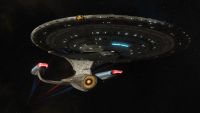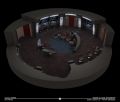Difference between revisions of "Ross Class"
m |
m |
||
| (10 intermediate revisions by the same user not shown) | |||
| Line 1: | Line 1: | ||
| − | + | __NOEDITSECTION____NOTOC__ | |
{{Sidebar\starship | {{Sidebar\starship | ||
| Line 11: | Line 11: | ||
}} | }} | ||
| − | + | ===Overview=== | |
| − | + | Introduced in 2381, the ''Ross-class'' introduced modern technologies into the now decades-old frame of the ''Galaxy-class'' in order to address shortcomings in the design highlighted during the Dominion War. | |
| − | + | ===Capabilities=== | |
| − | + | Equipped with advanced shield emitters, high-resolution sensors, modular laboratories, extensive diplomatic suites, and a secondary warp core located in the saucer section, the ''Ross-class'' is an upgrade over the earlier ''Galaxy-class'' in every way. The secondary core provides redundant power generation, and allows the saucer section to operate as an independent starship if required. Perhaps the most important upgrade, however, was the installation of the EXEO Core - initially envisaged as a Holographic First Officer, it was later refined into an integrated Artificial Intelligence and avatar for the ship's computer. The EXEO Core allows direct communication between ship and crew, in addition to acting as EMH or ECH when required. | |
| − | + | With the expanded laboratories and high-resolution sensors, the ''Ross-class'' is geared towards missions of exploration and diplomacy, capable of running dozens if not hundreds of studies and experiments simultaneous. The ''Ross-class'' is more than capable of holding her own in a battle, however, with ample firepower to hold its own against even the largest of Romulan warbirds. | |
| − | + | ===Mission Profile=== | |
| − | + | ''Ross-class'' Explorers are true multi-mission vessels, though they are most often assigned to exploration or diplomatic duties. Some act as test-beds for new technologies, such as upgrades to the EXEO core. | |
| − | Ross-class | + | === Vessels of Note === |
| + | {| width="50%" style="background: transparent" | ||
| + | ! colspan="3" style="background:maroon;"|Ross-class Explorers | ||
| + | |- | ||
| + | |USS ''Ross'', NCC-76710 <ref>Prototype</ref> || USS ''Archer'', NCC-76725 || USS ''Vanguard'', NCC-75148 | ||
| + | |- | ||
| + | |USS ''USS Yi Sun-Sin'', NCC-76545 || [[USS Aquila, NCC-76853|USS ''Aquila'', NCC-76853]] || USS ''Forrest'', NCC-75077 | ||
| + | |- | ||
| + | |USS ''Nechayev'', 75402 || USS ''DeSoto'', NCC-76729 || USS ''Nakamura'', NCC-75411 | ||
| + | |- | ||
| + | |USS ''Hanson'', NCC-76726 || USS ''Jellico'', NCC-76734 || | ||
| + | |} | ||
| − | + | === Image Gallery === | |
| − | + | <gallery> | |
| + | Image:Rossbridge.jpg|Ross-class Bridge Layout | ||
| + | </gallery> | ||
[[Category: Engineering]][[Category:Starship]] | [[Category: Engineering]][[Category:Starship]] | ||
Latest revision as of 00:42, 31 March 2024
| STARSHIP | |
|---|---|
 | |
| Class | Ross-class |
| Allegiance | United Federation of Planets |
 | |
| Specifications | |
| Type: | Exploration Cruiser (EC) |
| Length: | 663.2 Meters |
| Beam: | 398.9 Meters |
| Height: | 146.8 Meters |
| Mass: | 4,409,556.7 Metric Tons |
| Decks: | 42 Deck Plans |
| Crew Compliment: | Standard: 250 Officers, 600 Enlisted plus civilian specialists and families. Emergency: 6,000 |
| Warp Speed: | Main Core: Cruise Speed: 7.0 Sustainable Speed: 9.0 Emergency Speed: 9.2 (12 hour automatic shutdown) Auxiliary Core: |
| Impulse Engines: | Type: 3 Class 8 Main Impulse Engines (MIE) Speed: .85 C |
| Defensive Systems: | Type-1A Shield generator |
| Other Defensive Systems: | 30cm Ablative Armour |
| Armament: | Phasers: Dorsal 1x 270-degree Type-XI Array(Saucer); Ventral 1x 270-degree Type-XI Array (Saucer); Lateral 2x 60-degree Type-XI Arrays, one starboard, one port(Pylons); Ventral 1x 60-degree Type-XI Array (Secondary Hull); Torpedoes: 3x Rapid-Fire Photon Torpedo Tubes (2F/1A) Payload: 500 Photon Torpedoes. |
| Computer System: | Yori-Moto D4D019 |
| Tractor/Repulsor: | 2 Main Tractor/Repulsor Beams, 7 Shuttle-Docking Tractors 6 Docking Tractors |
| Shuttlecraft: | 1 Bay (A), 16 Shuttles (8 Type 18, 8 Type 14), 4 Runabouts (Delta Class) |
| Sensors: | SS Sierra 1a8 Deep Space Scientific Sensors Daystrom Industries HSCS-3SC-A Starship Sensors |
Overview
Introduced in 2381, the Ross-class introduced modern technologies into the now decades-old frame of the Galaxy-class in order to address shortcomings in the design highlighted during the Dominion War.
Capabilities
Equipped with advanced shield emitters, high-resolution sensors, modular laboratories, extensive diplomatic suites, and a secondary warp core located in the saucer section, the Ross-class is an upgrade over the earlier Galaxy-class in every way. The secondary core provides redundant power generation, and allows the saucer section to operate as an independent starship if required. Perhaps the most important upgrade, however, was the installation of the EXEO Core - initially envisaged as a Holographic First Officer, it was later refined into an integrated Artificial Intelligence and avatar for the ship's computer. The EXEO Core allows direct communication between ship and crew, in addition to acting as EMH or ECH when required.
With the expanded laboratories and high-resolution sensors, the Ross-class is geared towards missions of exploration and diplomacy, capable of running dozens if not hundreds of studies and experiments simultaneous. The Ross-class is more than capable of holding her own in a battle, however, with ample firepower to hold its own against even the largest of Romulan warbirds.
Mission Profile
Ross-class Explorers are true multi-mission vessels, though they are most often assigned to exploration or diplomatic duties. Some act as test-beds for new technologies, such as upgrades to the EXEO core.
Vessels of Note
| Ross-class Explorers | ||
|---|---|---|
| USS Ross, NCC-76710 [1] | USS Archer, NCC-76725 | USS Vanguard, NCC-75148 |
| USS USS Yi Sun-Sin, NCC-76545 | USS Aquila, NCC-76853 | USS Forrest, NCC-75077 |
| USS Nechayev, 75402 | USS DeSoto, NCC-76729 | USS Nakamura, NCC-75411 |
| USS Hanson, NCC-76726 | USS Jellico, NCC-76734 | |
Image Gallery
- ↑ Prototype
